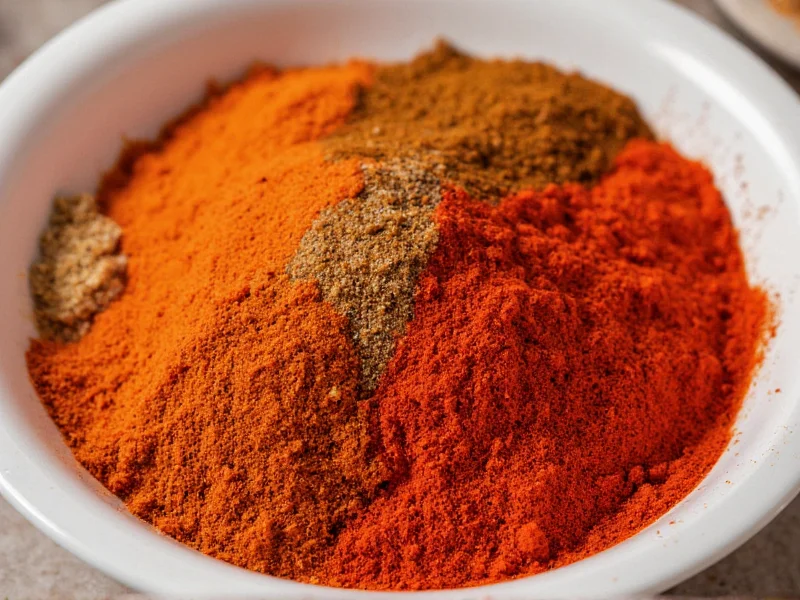Understanding the precise blend of kimchi spices is fundamental to creating authentic, flavorful fermented cabbage. Unlike generic spicy dishes, traditional kimchi relies on a carefully balanced spice mixture that enhances preservation while developing complex umami notes during fermentation. The magic happens when these spices interact with napa cabbage, radish, and salted seafood or vegan alternatives over time.
The Essential Kimchi Spice Components
Authentic kimchi seasoning isn't merely about heat—it's a symphony of flavors working in harmony. Let's examine each critical component and its specific role in traditional kimchi preparation.
Gochugaru: The Heart of Kimchi Spice
Korean red pepper flakes (gochugaru) distinguish authentic kimchi from other fermented vegetables. Unlike regular chili powder, gochugaru offers a unique combination of mild heat (typically 1,500-4,000 Scoville units), fruitiness, and vibrant red color. The coarse grind preserves essential oils that contribute to kimchi's characteristic aroma. When selecting gochugaru for kimchi, look for medium-coarse flakes with a deep red color—this indicates proper sun-drying that develops complex flavor compounds without excessive spiciness.
Garlic and Ginger: Flavor Amplifiers
Fresh garlic and ginger form the aromatic foundation of traditional kimchi spice blends. Garlic contributes sulfur compounds that interact with gochugaru during fermentation, creating new flavor molecules. Ginger adds bright, citrusy notes that balance the richness of fermented ingredients. The enzymatic activity in fresh ginger also aids the fermentation process. For optimal results in homemade kimchi spice mixtures, use freshly minced rather than powdered forms—this preserves volatile compounds that create kimchi's signature aroma profile.
Supporting Spice Elements
While gochugaru, garlic, and ginger form the core, several supporting ingredients complete the authentic kimchi spice profile:
| Spice Component | Traditional Amount | Primary Function |
|---|---|---|
| Minced scallions | 1 cup per 10 lbs cabbage | Adds fresh onion flavor and texture |
| Fish sauce or salted shrimp | 2-4 tbsp per batch | Provides umami and fermentation catalysts |
| Sweetener (sugar/pear) | 1-2 tbsp per batch | Feeds beneficial bacteria during fermentation |
| Asian radish (mu) | 1 cup julienned | Contributes enzymes and crisp texture |
Regional Variations in Kimchi Spice Blends
Kimchi spice recipes vary significantly across Korea's regions, reflecting local ingredients and climate conditions. Northern styles typically use less gochugaru and salt, creating milder flavors suited to colder climates where fermentation occurs more slowly. Southern kimchi often features more generous spice measurements and additional seafood elements, reflecting warmer temperatures that accelerate fermentation.
Jeolla Province kimchi stands out for its complex spice profile, incorporating wild sesame seeds and perilla leaves alongside standard ingredients. Meanwhile, coastal regions frequently include more diverse seafood elements in their kimchi seasoning, while mountainous areas might substitute wild greens for some scallions. Understanding these regional differences helps home fermenters create more authentic kimchi spice mixtures that reflect specific Korean culinary traditions.
The Science Behind Kimchi Spices and Fermentation
The interaction between kimchi spices and lactic acid bacteria creates kimchi's distinctive flavor development. Gochugaru contains capsaicinoids that initially inhibit certain bacteria while allowing beneficial Lactobacillus strains to dominate. As fermentation progresses, enzymatic reactions between garlic compounds and gochugaru create new flavor molecules that weren't present in the original spice mixture.
Proper kimchi spice measurements directly impact fermentation safety and quality. Too little salt compromises preservation, while excessive gochugaru can overwhelm beneficial bacteria. The ideal spice ratio creates an environment where desirable microbes thrive while preventing spoilage organisms. This delicate balance explains why traditional kimchi spice blends have been refined over centuries—they represent an optimal microbial environment for safe, flavorful fermentation.
Common Kimchi Spice Mistakes to Avoid
Many home fermenters make critical errors with kimchi spices that compromise both flavor and safety:
- Using regular chili powder instead of gochugaru—This creates overly spicy, one-dimensional flavor and lacks essential fermentation compounds
- Insufficient garlic—Garlic's antimicrobial properties help control the fermentation process
- Pre-mincing spices too far in advance—Freshly prepared spice paste maximizes enzymatic activity
- Incorrect salt ratios—Salt content directly affects which bacteria dominate fermentation
- Overlooking regional variations—Different kimchi styles require specific spice proportions
Vegan and Allergy-Friendly Kimchi Spice Alternatives
Traditional kimchi seasoning often includes fish sauce or salted seafood, but excellent vegan alternatives exist that maintain authentic flavor profiles. For vegan kimchi spice mixtures, substitute 2 tablespoons of fermented soybean paste (doenjang) plus 1 tablespoon of seaweed stock for every 3 tablespoons of fish sauce. This provides the necessary umami compounds and fermentation catalysts without animal products.
Those with garlic sensitivity can replace half the garlic with roasted onions, which provide similar sulfur compounds that support fermentation. For reduced sodium versions, maintain proper salt concentration for safety while using potassium-rich ingredients like kelp to enhance flavor without additional sodium. These thoughtful substitutions preserve the essential microbial environment while accommodating dietary restrictions in homemade kimchi spice preparations.











 浙公网安备
33010002000092号
浙公网安备
33010002000092号 浙B2-20120091-4
浙B2-20120091-4